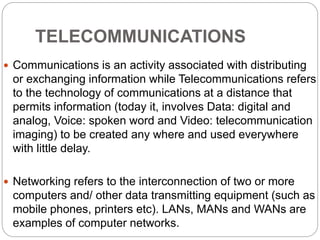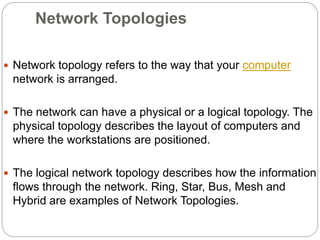Ad
Lecture6 Data Networking.pptx
- 2. TELECOMMUNICATIONS Communications is an activity associated with distributing or exchanging information while Telecommunications refers to the technology of communications at a distance that permits information (today it, involves Data: digital and analog, Voice: spoken word and Video: telecommunication imaging) to be created any where and used everywhere with little delay. Networking refers to the interconnection of two or more computers and/ other data transmitting equipment (such as mobile phones, printers etc). LANs, MANs and WANs are examples of computer networks.
- 3. Networks Computer Networks are categorized into three: that is, LAN, MAN and WAN Local Area Networks (LAN) Metropolitan Area Networks (MAN) Wide Area Networks (WAN)
- 4. Local Area Network (LAN) Small interconnected of personal computers or workstations and printers within a building or small area up to 10 kilometers. Small group of workers that share common application programs and communication needs. LANs are capable of very high transmission rates (100s Mb/s to G b/s). LAN equipment is usually owned by organization. Medium may be owned or leased from telephone company provider or common carrier.
- 5. WANs WANs were developed to communicate over a large geographical area (e.g. lab-to-lab; city-to-city; east coast- to-west coast; North America-to-South America etc). WANs require the crossing of public right of ways (under control and regulations of the interstate commerce and institute of telephone and data communications established by the government and international treaties).
- 6. WANs around the world rely on the infrastructure established by the telephone companies (“common carrier”) or public switched telephone network (PSTN). WANs consist of a number of interconnected switching. Transmission signals are routed across the network automatically by software control to the specified destination. The purposes of these nodes are to route messages through switching facilities to move data from node to node to its destination.
- 7. Network Topologies Network topology refers to the way that your computer network is arranged. The network can have a physical or a logical topology. The physical topology describes the layout of computers and where the workstations are positioned. The logical network topology describes how the information flows through the network. Ring, Star, Bus, Mesh and Hybrid are examples of Network Topologies.
- 8. Bus Topology Each node is daisy-chained (connected one right after the other) along the same backbone. Information sent from a node travels along the backbone until it reaches its destination node. Each end of a bus network must be terminated with a resistor.
- 10. The Nodes can be computers or any other devices that are able to communicate (share data) in a Computer Network. The Backbone is a communication media: that is, the means of connection between the communicating devices. Twisted pair cables, coaxial cable and fiber optic cables are good instances of communication media.
- 11. Ring Topology Similar to a bus network, rings have nodes daisy chained, but the end of the network in a ring topology comes back around to the first node, creating a complete circuit. Each node takes a turn sending and receiving information through the use of a token.
- 13. The token along with any data is sent from the first node to the second node which extracts the data addressed to it and adds any data it wishes to send. Then second node passes the token and data to the third node, etc. until it comes back around to the first node again. Only the node with the token is allowed to send data. All other nodes must wait for the token to come to them.
- 14. Star Topology In a star network, each node is connected to a central device called a hub. The hub takes a signal that comes from any node and passes it along to all the other nodes in the network. In a star network, each node is connected to a central device called a hub. The hub takes a signal that comes from any node and passes it along to all the other nodes in the network.
- 16. Hybrid network A Star network topology can be blended with network topologies like the Ring and to Bus topology to form a hybrid network topology.
- 17. Basic transmission medium concepts Medium is the physical path between transmitter and receiver in a data transmission system. In Guided Medium, the waves are guided along a solid medium path (twisted pair, coaxial cable, and optical fiber). In Unguided medium, the waves are propagated through the atmosphere and inner/outer space (satellite, laser, and wireless transmissions).
- 18. Medium examples by type Conductive: twisted pairs and coaxial cables Electromagnetic: microwave Light: lasers and optical fibers (need clear line of sight) Wireless – inner/outer space; satellite (Omni directional security issues)
- 19. Coaxial cable This is the widely used medium and is installed for use in business and corporation Ethernet and other types of LANs. It consists of inter copper insulator covered by cladding material, and then covered by an outer jacket.
- 20. Applications of Coaxial cable : TV distribution (cable TV); long distance telephone transmission; short run computer system links Local area networks
- 21. Twisted Pair Cables Each wire with copper conductor Separately insulated wires Twisted together to reduce cross talk Often bundled into cables of two or four twisted pairs If enclosed in a sheath then is shielded twisted pair (STP) otherwise often for home usage unshielded
- 22. Optical Fibers Multimode fiber is optical fiber that is designed to carry multiple light rays or modes concurrently, each at a slightly different reflection angle within the optical fiber core. It is used for relatively short distances because the modes tend to disperse over longer lengths (this is called modal dispersion). For longer distances, single mode fiber (sometimes called monomode) fiber is used. In single mode fiber a single ray or mode of light act as a carrier
- 23. Physical Description of optic fiber Glass or plastic core of optical fiber = 2 to 125 µm Greater capacity; 2 Gb/s over 10’s of Km Smaller size and lighter weight Cladding is an insulating material Jacket is a protective cover Laser or light emitting diode provides transmission light source Greater repeater spacing – fewer repeaters, reduces line regeneration cost
- 24. Wireless Transmission Satellite is a microwave relay station. Satellite ground stations are aligned to the space satellite, establishes a link, broadcast at a specified frequency. Ground station normally operates at a number of frequencies. Satellite space antenna is aligned to the ground station establishes a link and transmits at the specified frequency. Satellites are capable of transmitting at multiple frequencies simultaneously, full duplex. To avoid satellites from interfering with each other, a 4
- 25. Network Devices Network devices are components used to connect computers or other electronic devices together so that they can share files or resources like printers or fax machines. Devices used to setup a Local Area Network (LAN) are the most common type of network devices used by the public. A LAN requires a hub, router, cabling or radio technology, network cards, and if online access is desired, a high- speed modem.
- 26. Hubs A hub is the central component place where data converges from one or more directions and is forwarded out in one or more directions in a LAN. There are four components in a basic wired hub network:
- 27. These are : 1) Ethernet cable: This is the physical cable that links the computers together, enabling them to communicate. The Ethernet cable, also called twisted pair, or 10-Base T, plugs into a network card located in each computer on the LAN. 2) Network Interface Cards (NICs): One of these cards goes into a vacant PCI slot inside each computer. The back of the card features a port for one end of an Ethernet cable. Newer computers normally have a networking card built-in.
- 28. 3) Networking Hubs: The networking hub is a junction box with several ports in the back for receiving the Ethernet cables that are plugged into each computer on the LAN. With Ethernet cables going from each NIC to the hub, all computers are connected to the hub. 4) Networking Software: Most operating systems today come with networking software built-in, but the software is also available from third parties. The software works with the hardware to create a networking environment on each computer, allowing the user to see shared files and recourses. It also allows for administration of the network.
- 29. With a group of computers wired to the hub and the software installed, the computers can talk to each other. Networking hubs will broadcast all traffic that comes through the hub to all machines or nodes connected to the LAN. Each computer/node on the LAN will have its own address, called a MAC (Medium Access Control) address. Each node will ignore any traffic not addressed to its MAC address.
- 30. Networking hubs are simple devices that are fine for home use in most cases, but not considered optimal for workplace environments. Networking hubs can only operate in half-duplex mode -- a computer cannot receive and send transmissions at the same time. Another drawback is that networking hubs broadcast traffic indiscriminately to all machines on the LAN. This opens the door to security issues, making it easy to use so-called "packet sniffers," for instance, to snoop on all network traffic.
- 31. Gateway A gateway is a network point that acts as an entrance to another network. On the internet, in terms of routing, the network consists of gateway nodes and host nodes. Host nodes are computer of network users and the computers that serve contents (such as Web pages). Gateway nodes are computers that control traffic within your company’s network or at your local internet service provider (ISP). A gateway interconnects dissimilar protocols and servers,
- 32. Router A router is a device or a software in a computer that determines the next network point to which a packet should be forwarded toward its destination. Allow different networks to communicate with each other. Routers create and maintain a table of the available routes and their conditions and use this information along with distance and cost algorithms to determine the best route for a given packet. A packet will travel through a number of network points with routers before arriving at its destination. A router
- 33. Bridge A bridge is a product that connects a local area network (LAN) to another local area network that uses the same protocol (for example, Ethernet or token ring). A bridge examines each message on a LAN, "passing" those known to be within the same LAN, and forwarding those known to be on the other interconnected LAN (or LANs). A bridge interconnects two LANs that use the SAME logical link control protocol but may use different medium access control protocols.
- 34. Switch A networking switch is the central device in a wired or wireless LAN (local area network). It receives signals from each computer on the network via Ethernet cables in a wired network or radio waves in a wireless LAN. In both cases, the networking switch directs traffic across the LAN, enabling the computers to talk to each other and share resources. It allows different nodes of a network to communicate
- 35. A networking switch runs in full-duplex mode, meaning a machine on the LAN can receive and transmit data simultaneously. This is much faster than a networking hub, an alternate device that serves the same purpose as a switch but operates in half-duplex mode, allowing each machine or node either to send or receive at any given time. Another key difference between a networking switch and a hub is that the switch sends traffic discriminately, using addresses to direct traffic packets exactly where they are supposed to go.


















































































